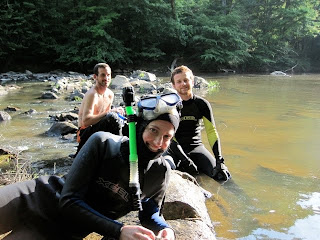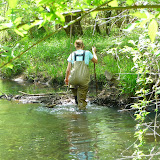The winter trips were nice because most of the aquatic vegetation was dead and we could get a real feel for where the beaver dams were located (see left photo below). Come spring, the taro, saw grasses, and cattails were back making the study sites feel more like a swampy jungle in southeast Asia than the Piedmont of North Carolina (right below).
The spring water collection trips were pleasant. You could decide to go with waders or without. Water temperatures were about 19 degrees C (66 F) and easily wadeable. However, my philosophy has always been to keep a barrier between you and well... the things you can't see, whether that be a wetsuit, pair of pants or canvas waders. There are several good reasons for this. One of the members of our team decided to go without waders..... and encounter several of the slithering organisms shown below.

About a 4-inch purple leach speckled with bright orange spots. I looked down at my friends leg, with blood coming through his pants. He pulled up his pant leg to reveal an open lesion, no leech, but perfect circular bite mark. Now for some, they get the creeps thinking about something attached to a leg, slowly sucking out blood with a series of circular teeth. But for others, like my friend, "they're are really cool, you know?" Leeches are one of the most understudy groups of organisms in the world. They are highly diverse and quite fascinating. There are approximately 700-1,000 different species of leeches globally, found in both aquatic (ranging from marine to freshwater) and terrestrial environments. Leeches use a variety of mechanisms to find their prey, including chemoreception (chemical), mechanoreception (movement and vibrations), photoreception (simple eyes able to detect light changes and movement), and even sonar. Additionally, not all leeches suck blood. Some leeches are predatory and use a proboscis like a needle to impale prey items. And contrary to common thought, they aren't the typically cold-blooded, blood-sucking bad guys. Several species of leeches partake in different forms of parental care, including such behaviors are nest building and carrying their young and eggs on their bellies. Some even have marsupial pouches and feed their young. So maybe my friend is right.... And if I don't have you convinced yet, just know that leeches are still used in many modern medical practices today for blood disorders, and unlike ticks and other blood suckers, leeches don't carrying any communicable diseases.
This information is courtesy of a manuscript produced as part of http://www.invertebrate.ws
Text is Copyright © 2004 by Fredric R. Govedich and Bonnie A. Bain.
For more information about leeches visit: http://www.invertebrate.us/leech/info/leech.pdf

















